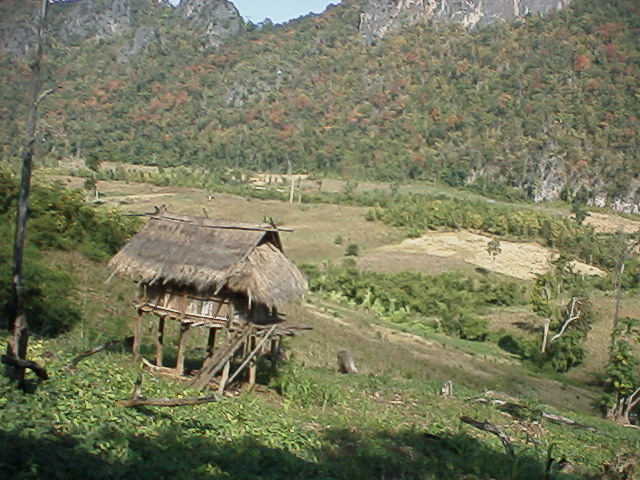
Around the World 1998; Northern Thailand
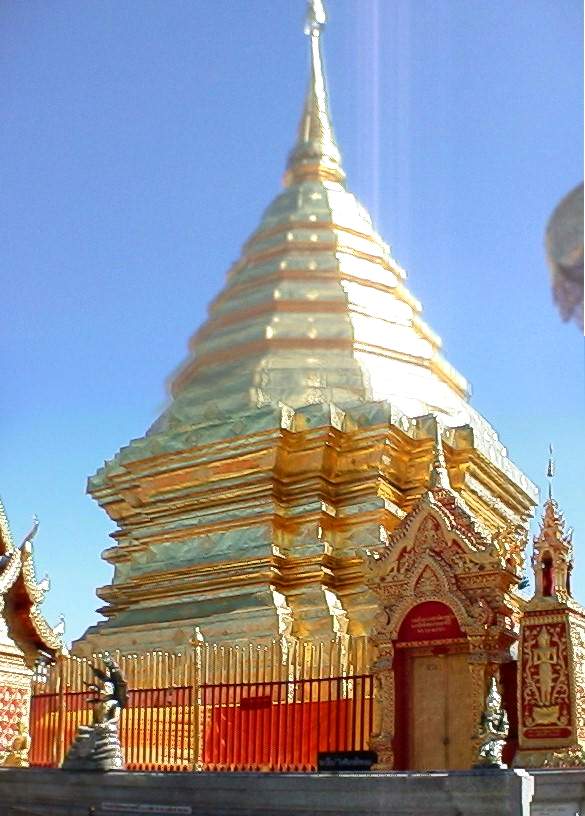
Note; this post is recreated from the original wired2theworld website post with the dates below. The old posts were reformatted in 2018 and 2019 for the 20th anniversary of wired2theworld. As much as possible, the content is unchanged and unedited from the original, only some formatting, spelling, and link errors have been corrected.
Kristina and David’s Round-The-World Journal:
THAILAND: Part 2/ Northern Thailand
US$1=35 Baht
Kristina’s Journal:
November 16, 1998 Chiangmai, Northern Thailand
We took the night train up here from Bangkok and had to have upper berths because they were the only ones left. I will never do this again if I can avoid it. The upper berth is much narrower than the lower by about 8 inches and is right next to the air condition vents which are on the ceiling. This meant that it was absolutely frigid and the towel that passes for a blanket was useless. All of our warm clothes were buried deep inside our packs. At the Chiangmai Rail station we tried to book our return ticket back on a sleeper, but they were all full for the day we wanted. This puts us in a bind because we have to be back in Bangkok by the 24th because we already booked and paid for a hotel there. We may wind up taking a bus (David shudders) back or flying if David gets his way.
When we arrived we were picked up by our guesthouse, SK Guesthouse, which we had booked through (what we thought was) the Thai Tourism office in Bangkok. It’s not bad for 200B a night.
Today we met with someone about going on a trek that includes cooking classes. The main reason most people come to Chiangmai is to go on a trek up into the mountains to see the hill tribes. Most treks include 3 days, two nights, lots of walking through the jungle, an elephant ride, a river raft ride, sleeping in a hill tribe village, and gawking at the locals who may or may not want you there.
Another common thing some people come for is to smoke opium which is grown in the hills and used by many of the tribal elders. It is also smuggled and trafficked and turned into heroin and sold all over the world. So, some people come looking for it and they can find it if they want. We don’t. In fact we want to avoid it and have shied away from treks with testimonials from satisfied customers who said they found lots of “mind bending substances” along the way. We have been warned to go with a legitimate trekking guide, but it’s hard to tell because all the guesthouse and travel agents here advertise treks. It’s hard to tell what’s good and what’s not. Most treks average in cost 1600-2400 B and include basic food and lodging in the villages for the 3 days/2 nights.
The “trek” we are looking at is slightly different. My mother found it mntioned on a web site called thaifocus.com and e mailed the info to us. Today we met with Angela, an Australian, and her Thai husband, Noi, who run the trek. Noi is a former trek guide and it is he who gives the cooking classes. It includes transportation to a tribal village which doesn’t see many tourists, lodging in the village, all food, 4 cooking classes, an elephant ride, rafting, and transport back to Chiangmai. The difference is that you stay in the village for 3 days, not spending most of your time huffing through the underbrush. Sounds like a good start. There is also a village school up there that David might get a chance to see. It’s a bit more expensive (3850 B per person), but it does include the cooking classes (which run about 750-800B per day here in town), and as of right now, we would be the only people up there with Noi. Another plus is that supposedly no other tours or treks come through the village while they are there, and Noi speaks the local Burmese dialect that the villagers speak (they don’t speak Thai).
November 18, 1998 Chiangmai, Wat Doi Suthep
It is hot here, don’t let anyone try to tell you it will be cooler up in the hills of Chiangmai. Actually, it was a bit cooler up the hill yesterday but as soon as you get back into town sweat stars pouring again.
We decided to break our fog of indecision and actually get out and see something yesterday. So, we rented a little 100 cc Honda Dream scooter and went cruising around town and up the hill to see Wat Doi Suthep. This was a bit terrifying for me because I was on the back of the scooter as we wound our way up the mountain to the temple and very large tour buses were coming down the curvy road right at us. But, we made it and it was worth the drive.

First, there is a huge staircase that is flanked all the way up by tile mosaic dragons with several heads at the bottom. Then, at the top, there is a large wat, or temple and a great view of the Chiangmai valley below. This temple supposedly holds a Buddha relic, a tiny bone from His inner ear, so many thousands of people make a pilgrimage here every year. Everything seems covered in gold and it is!
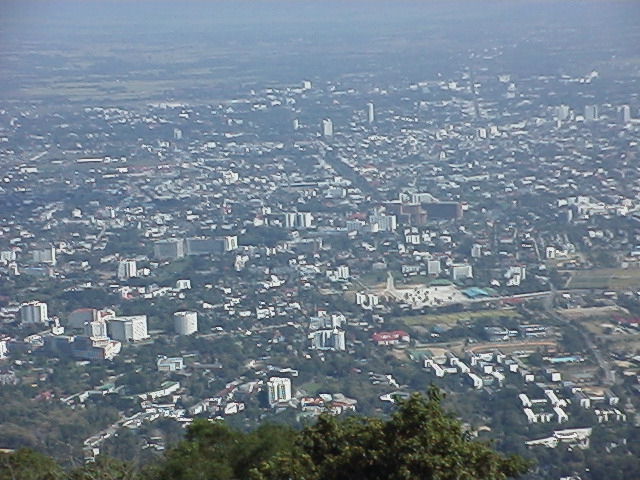
One of the other things we did while we had the scooter was to go to the train station and buy our tickets back to Bangkok. They were sold out for every time we wanted so we will
Tonight we went to visit the Night Bazaar here in Chiangmai. It’s basically like a huge swap meet with many, many vendors repeating themselves. There are some hill tribe handicrafts, but not much special. Not really anything that isn’t available in Bangkok.
David got very sick tonight, his first bout with Buddha’s Revenge on this trip. We were worried that we might have to cancel our trek, but it doesn’t look like it. It’s not surprising that he got sick
David’s Diary:
November 23, 1998 Back from the hills
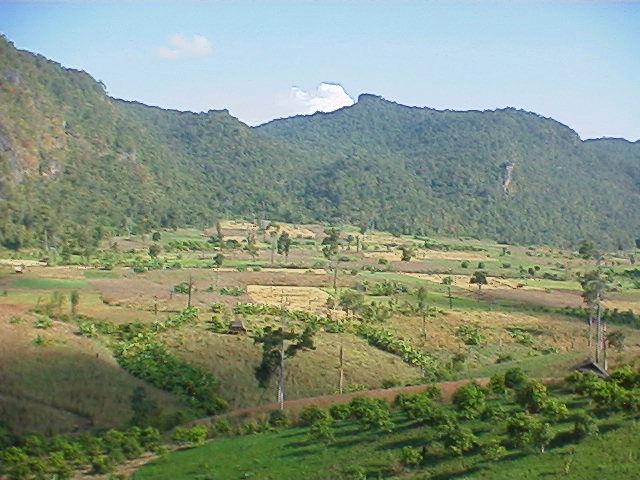
We came down from the mountains of Northern Thailand a little wiser and just a bit more humble for our experiences. We had chosen the trek offered by Noi and Angela, through the Crusty Loaf Bar and Grill in Chiangmai for a few reasons: first, it integrated the cooking school with the trek in an interesting and efficient way. Second, and perhaps most important, we would be the only participants, and on these treks, that is something of a rarity. Third, we were assured that no other trekking groups would be staying in this village while we were there, thus assuring us an individualized experience. Fourth, we would actually be based in one village for the duration, instead of walking from village to village, stopping only to sleep in two different spots, but never spending any time in any one village. It cost a little more than the rest of the treks, but not so much that it was prohibitive by any means, and this was one of those times that you got what you paid for. Let me begin at the beginning…
Day one: we are in the back of Noi’s trusty pickup truck, and I feel terrible. I spent the entire night before gripping the toilet seat with white knuckles as I purged the contents of my poor tired stomach over and over again, down to the very last grain of rice- which I remarked had been quite stubborn, and held on to the bottom during so many rounds of dry heaves. Finally able to hold down water ( a feat in itself ), I had slept all of one hour before the sun was pounding against my eyelids, letting me know most unsympathetically that it was time to get up and go.
I was not going to cancel the trip just because my tummy had been upset- what real man would?- so I bravely got ready and heaved the bags downstairs, opting to skip breakfast, as I picked something vaguely familiar from the back of my front teeth. We stopped on the way up to the village at two different local open markets to do the shopping for the cooking school, and the smells were a meal in themselves, especially in my condition. Kristina will want to describe these markets in greater detail as she was much more able to focus at the time.
The road up into the hills is a long and windy

We were shown to our hut, a little bamboo and grass construction with plenty of natural ventilation, and deposited our things. Our afternoon was to be devoted to the first of three cooking classes, all of which would take place in our host’s bungalow.

The home of our host and his family was quite large and well appointed by village standards. He lives with his wife, their two sons, their daughter, their daughter in law, and three grandchildren. All the bungalows in the village are built in a similar style, raised off the ground about six to eight feet, to provide shelter for the animals and room for drainage from the monsoonal flooding in the hills. The floors are bamboo, as are the walls, and the roof is thatched
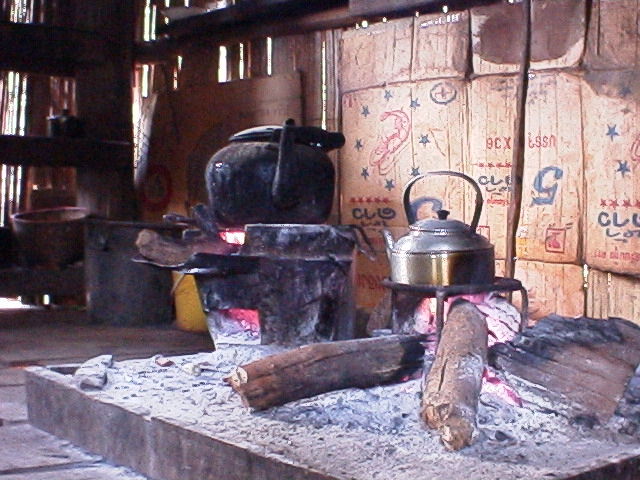
What struck me the most, upon entering for the first time was the hearth. To one side of the main room was an open wood fire, on a
We are situated about 25 miles from the Thai / Burmese border, and the people of the Palong tribe are of Burmese origin. Political oppression forced them to come to Thailand only 9 years ago, making them a recent addition to the collection of hill tribes. The women wear a brightly colored sarong, with a dark red jacket, and colored tassels on woven armbands. Their head covering is simple, a multi-colored towel essentially, wrapped in loose turban fashion around the head. Everyone over the age of eighteen or so chews betel nut. Because tobacco is so expensive, I was told, the chewing of the betel nut has become the widespread alternative to smoking. Betel nut apparently has a mild narcotic effect on those who chew it, and like tobacco, is fairly addictive. Most distinctly, the use of this nut has aesthetic repercussions on a grand scale to the observer of western sensibilities. The deep red and black juice that comes from the nut stains the teeth, tongue, and lips of those who use it, giving the people of the hill tribes (the practice is common among all the hill tribes) a singularly macabre and unattractive smile- in the opinion of this westerner. It obviously does not bother the people of the hill tribes, as they continue to marry, have children, etc.
Note from 20 years in the future; we no longer recommend or support the riding of elephants anywhere. If we’d known what we know now about how they are (
Day 2: This morning we had plans to visit three other villages, two of Chinese origin, The Akha and Lissue, and one other of Burmese, the Karen. Noi prepared us a breakfast of soft rice soup, which was a little different, but not altogether unappealing. We were greeted shortly
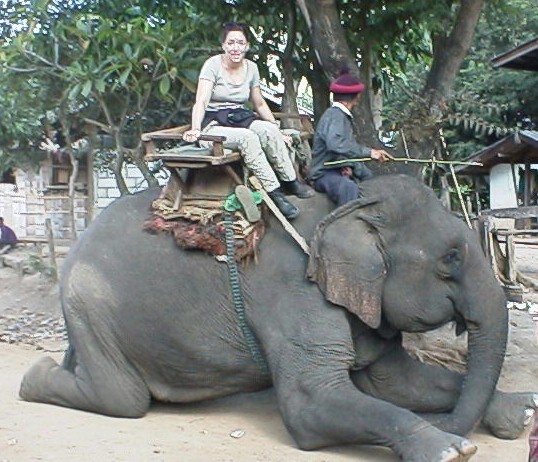
We mounted the great pachyderm from the elevated porch of our host’s residence, and sitting side by side in a wooden bench saddle, we lumbered off through the forest. It was clear and sunny, but not too hot in the shade of the forest canopy. Traveling by elephant is not so unpleasant, although the novelty wears off after a little while. The small,
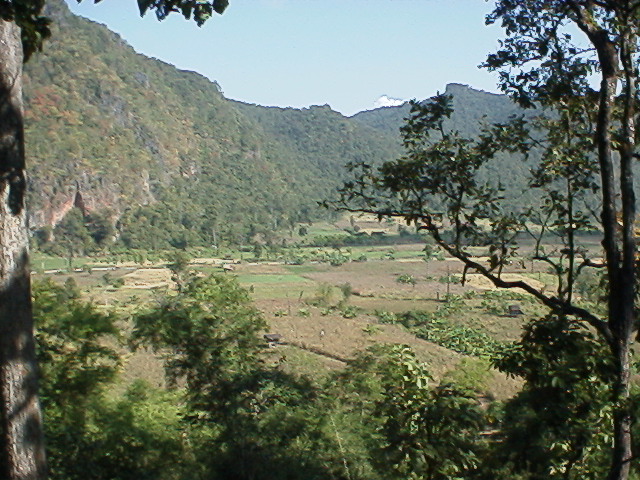
We entered the next valley, and the trees parted to reveal a gorgeous vista of fields and rice paddies. There were huts here and there, usually connected to a field, and people were out in some of the fields working. The guide pointed towards the head of the valley, and said, “Akha”, indicating that we were near our destination. Noi would be waiting for us in the Akha village with the truck, as we were on the upscale trek, and would not be required to walk from village to village. There are those who might think us disgustingly bourgeois for not choosing the walking trek, but our afternoons were devoted to learning all about Thai cooking, back in the Palong village, and walking from settlement to settlement would have been far too
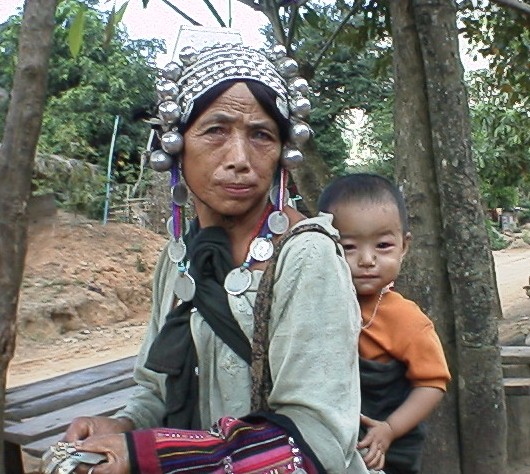
In the Akha village, we were invited into the headman’s hut, by his widow. It turned out that the headman was present, however, as the box containing his body was placed prominently in the main area of the hut. Akha huts are quite distinct from Palong huts, in that the are divided into two equal sections, by a partition that bisects the living space by about two thirds the distance from one wall, leaving room to pass from side to side. One side is for the men, and the other is for the women, married and otherwise. Each side has its own cooking hearth, identical to the hearth in the Palong village. Men and women in the Akha tradition do not eat together, or cook together. Yet, they still manage to have large families!
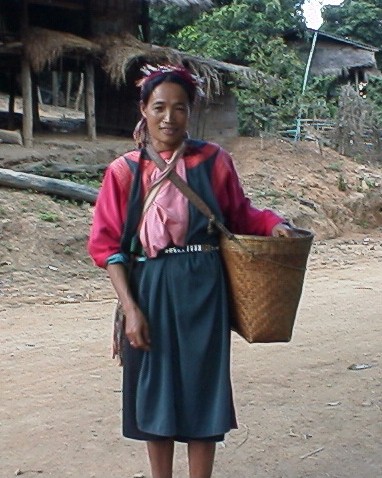
We purchased a woven water bottle sling from a
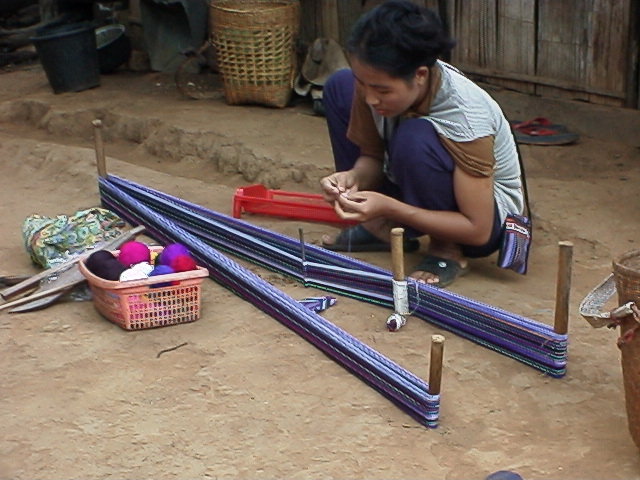
From Akha, we moved on down the road about two kilometres until we arrived at the Lissue village. In this village we discovered the woman whose water bottle sling we had purchased, and the origin of that and other woven goods. It was reassuring to see that the item that we had purchased was indeed a handmade, hand-woven piece of village craft. There were two women working the loom in front of us, and it was a loom like no other I have seen. Several wooden stakes had been driven into the ground, forming a long triangle, upon which the women were weaving long, thin bolts of multicolored fabric; They were making the same fabric that our water sling was made from. A third woman was hand stitching detail patterns onto finished sections of identical fabric. I felt much better about paying for the item we had bought, wondering even if they were underpaid for their labor. This was just western guilt, no doubt.
From the Lissue village, we ventured up the road several kilometers until reaching the Karen village school. This was, for me, an enlightening experience, coming from the inner city schools of South Central Los Angeles, which I had always thought to be the bottom of the barrel in terms of materials and facilities. The Karen school was a single room with walls that didn’t go all the way to the roof. There were kids everywhere, of all ages.

But the first thing I noticed about the situation was that there were no adults, not a teacher in sight. Noi explained that corruption in the education bureaucracy had resulted in a general
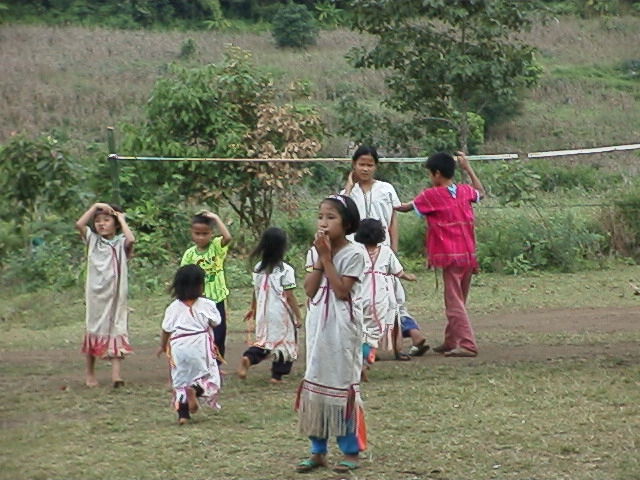
We went from this school to another school, much closer to the village where we were staying. The Palong school was much larger than the Karen school, and in contrast, had some adults present. We arrived at lunchtime, which allowed us an opportunity to peek into some classrooms without disturbing anyone. The students were eating a school prepared lunch of soup and noodles, which looked fairly edible. In one of the classrooms, some students were studying an ABC reader with
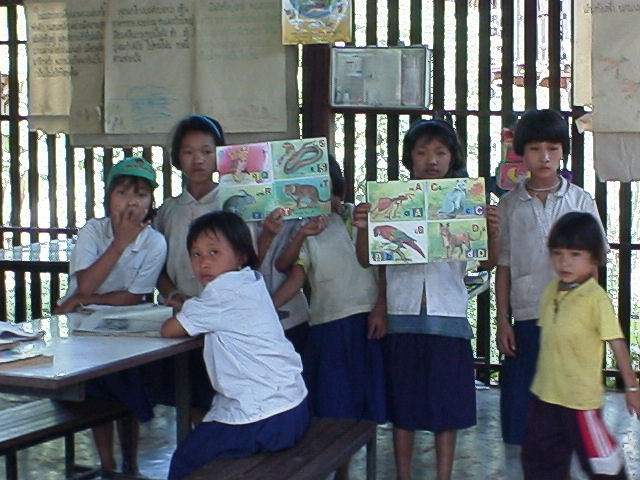
Feeling somewhat relieved, we walked from the school to the temple, a cave temple located in a giant fissure in the rock wall. Inside were several Buddhas, candles, little shrines, and the monk’s laundry hanging out to dry. It was an interesting blend of the holy and sacred, with the rural and personal. We felt uncomfortable eating there, so we took our pack lunch of noodles with pork, carefully packed in banana leaves, in bamboo baskets, to the spot where the schoolchildren were eating their lunch. It was a day of much learning for us.
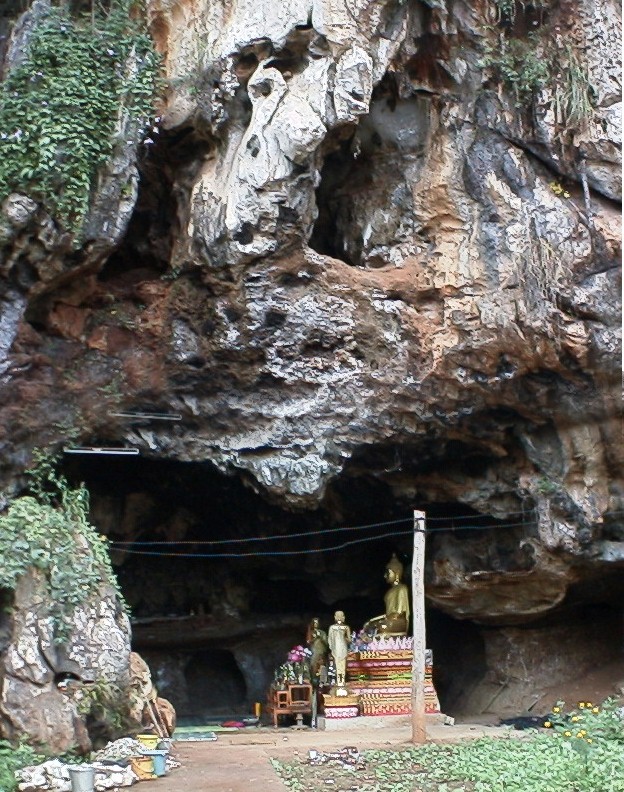

David’s Notes: Hill Tribes
There is significant pressure on the part of the government to maintain the image of the hill tribes as they are, prohibiting their natural development and progress as members of society. Contrary to what farang trekkers might be led to believe, either about their so-called “non-touristed” destinations or about the desires of the hill tribes to be isolated in order to preserve their way of life, the reality is quite different.
The government mandates that the tribes, primarily nomadic, remain in one location and not move around, as was their historic tradition. Certain tribes are not allowed machinery they need to farm more effectively, even though they are told to become farmers and leave their nomadic lifestyle behind. Motorbikes are to be kept out of sight, and certain villages can’t have any at all. This does not mean that the hill tribes see the motorbike as a threat to their way of life. It is merely a faster way to get to town, I believe. The ‘why’ is simple to address in this case. If the hill tribes progress to the level of the average village society, then the huge industry in trekking, which is Chiangmai single most important cash cow, would be defunct.
So trekker, beware. That “non-touristed” tribe you are going to visit has only got that label to appease the throngs of trekkers just like you that make their way through it every day.
Don’t be fooled, the trekking path has no tribes of people that have limited contact with the outside- only oppressed tribes with the outside world shoved constantly in their faces.

Kristina’s Journal:
November 20-23, 1998 Northern Thailand Hill tribes and Cooking Classes
Well, David’s covered quite a bit, so let me put in my two cents. In keeping with our theme of you get what you pay for (actually, I’m thinking of renaming the site www.yougetwhatyoupayfor.com) we decided that the personalized attention, cooking classes, and extended time spent in one village, was worth the extra money. And it was.
Noi picked us up in his truck and our first stop was a local’s market in Chiangmai. Here we bought produce, pork, chicken, chilies, and curry paste from the outdoor vendors he normally uses. The sights and smells were incredible, and not for the faint of stomach. Not much was on
Our next stop, after dropping our big bags at Noi’s house (and yes, we left the computer), was another market in a very small town that serves as the last stop for most treks in that area. We noticed many other trekking groups, all in pickups filled to the max, stopping to buy supplies. This market was much the same as the last, and here we bought only a few more items. I did get a chance to ask Noi about the cooked insects
We stopped for lunch and had a very simple meal of chicken, vegetables,
When we got to the village, we were shown to our little bamboo hut which was more holes, than bamboo. I was afraid that David would drop through the floor and onto the chickens below at any moment. We were given mats and blankets and a mosquito net. We were pleased yet again that we had our own pillows.
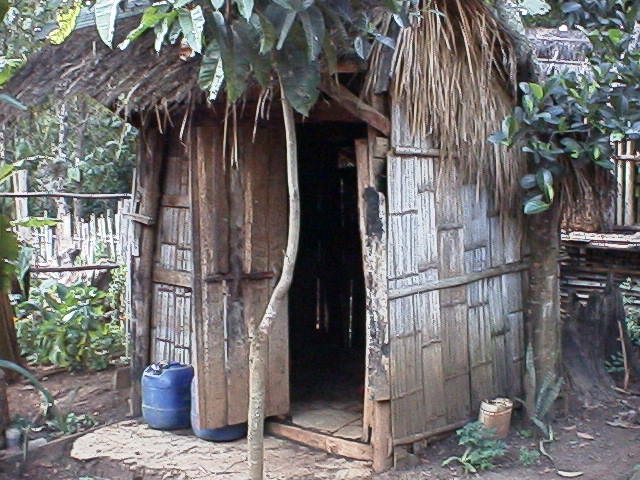
Next, we checked out the “toilet” hut and the “shower” hut. We had been told that the head of this household was one of the more entrepreneurial villagers because he had built the huts for trekkers and had his own toilet. Our hut was actually built for one of the unmarried sons but it wasn’t always in use and there was a much larger one built for larger groups of trekkers. The toilet was a porcelain basin sunk into the ground and flushed with the bucket method.
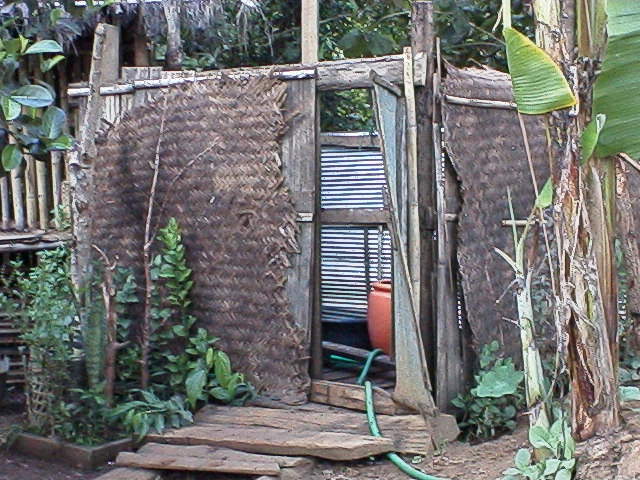
The shower was an open air platform surrounded with bamboo walls and containing a few large barrels of water and a scooper and built mostly for visitors. Most of the villagers bathe at a pump/well that is in the center of the compound. It is a social event, attended by both sexes, women wearing sarongs, and men wearing shorts or pants. Laundry is often done at the same time.
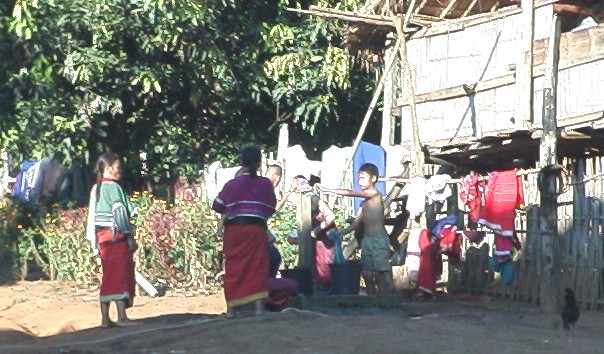
Our first cooking class was held
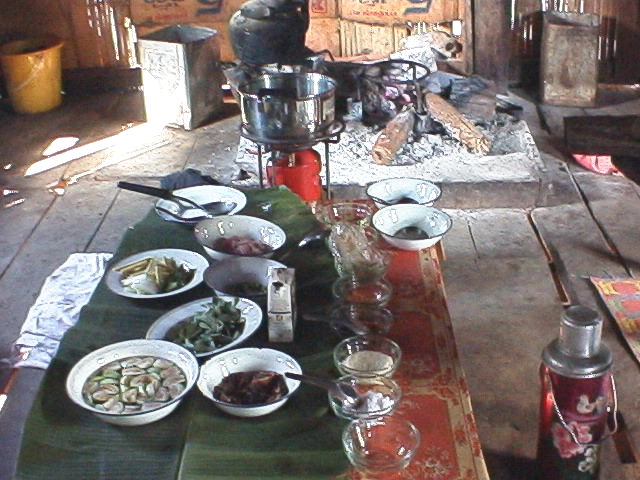
As he cooked, I asked a few questions, noticing that cooking methods and ingredients tended to repeat themselves. Noi’s
“What about duck?” I asked, wondering about one of my favorite foods.
“Yes, the other village we go to tomorrow eat duck”, he said. “Very special, eat black duck when cold.”
“Oh! I like duck. Like Chinese duck with crispy skin”, I said.
“Yes, they are originally Chinese people”, he said.
“I think he means dog“, said David
“No!” I said, “Dog or duck?” I asked him.
“Duck, D-O-G” said Noi.
“Oh, no! I mean duck, you know, quack, quack…”
Much laughter followed.

After the cooking class, we both felt a little guilty as we sat on the balcony trying to eat all this food. We tried to get Noi and the family to join in, but he wouldn’t. The food was shared among everyone after we had finished. Noi told us that this was not the type of food they ate ate, but they were interested in trying it. He said their food was much more “simple” and did not often contain very much meat.
That night, once the sun went down, it was dark, and not too much to do. David went to sleep and I tried to read by the dim light of an oil lamp. At night, we discovered, the bathroom becomes a scary place. The light of the torch revealed a giant spider, very similar to the one we saw in Cape Tribulation. The next night revealed two of these spiders and a small scorpion. It becomes a little difficult to drop your pants, squat, and turn your bare butt to a spider that large only inches away.
The next morning we had a breakfast of boiled rice soup with green onions, tofu, and chicken. Then it was off by elephant to tour some of the other villages as David described above. I do have to add that I was a bit nervous as we went into the head woman’s house in the Akha village to view her dead husband (especially after we learned he had already been dead 19 days). I was much relieved when I saw he was interred in a small,
In the afternoon we had our second cooking class. Noi showed us Tom Ka Kai (chicken with coconut milk soup, Kaeng Ped (red curry with pork), Pat Pet Mamoung Kai (fried chicken with cashew nuts), Pa Nang (red chilies with fried pork), Thai salad with egg, and Tom Ma Kau (smashed eggplant dip).
To check out a few of the recipes, click here…
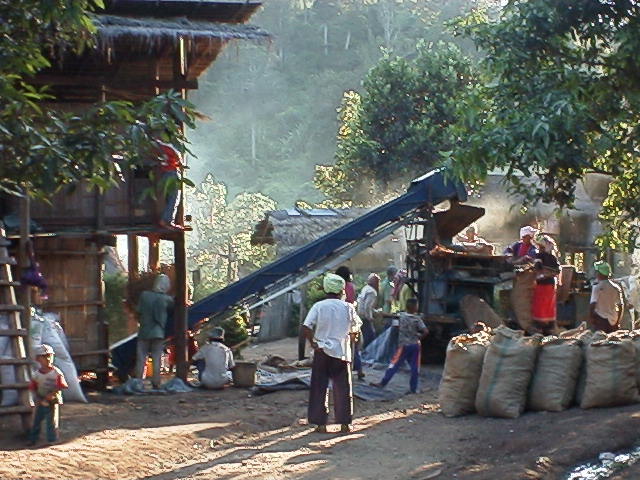
That night there was a party in the village given for a 12 year old girl who was to be married in two days to a 17 year old boy from a neighboring village. Members from his family came to meet with hers and much food and alcohol was consumed. At one point I ventured outside to go to the bathroom and when I returned I was followed inside our hut by a very drunk young man. As surprised as I was that he just walked inside and sat down on the floor, I think he was equally surprised to see David lying on the mat under the mosquito net. Ten seconds later a friend joined him. There they sat, not speaking English, but trying to talk to us in their dialect. They asked us if we wanted a drink, we declined. They asked David if he wanted a massage and said we were going to sleep. They left as quickly as they came in. The next morning I told Noi of this encounter and he relayed it to the family. They said they were probably young men from the other village who had just had too much to drink.

The next morning we had a chance to sit and talk with the 17 year old daughter in law in the family, with Noi acting as interpreter. She already has a beautiful 1 year old daughter and has been married for 2 years. It is not uncommon for girls to marry at age 13 or 14 with the marriage arranged by the families (needless to say, they cease going to school around this time). However, she did say that 12 years old was too young even for them and then she gave us the local gossip; the girl had spent the night out in a field with the boy and now they had to get married. It was not implied that she was pregnant, rather that custom states that if a boy and a girl spend any time alone together they have to get married.
She then showed us some photos from a friend’s wedding in the village and I asked her if she wanted to see our pictures (I carry about 15 photos from home, including a few from our wedding). Her first comment was that my dress was white, very uncommon here, and that we must be rich because it looked so expensive. She had never seen such a dress before. Her friend, sitting next to her, said that she had seen one once in a photo. She then looked at the pictures of our friends, my parents, grandparents, cats, and the Grand Canyon, Venice Italy, and Paris. She liked the cats. She and her friend were most interested in the photo of my friend Linda’s children, and they asked if we had any babies. Not yet!
After we had lunch, the women of the household, young and old, and many of their friends, came inside to eat a special meal for the upcoming wedding. They had a soup made out of dried bitter greens, white “pumpkin” (squash) and pork, steamed rice which was eaten with the hands, a bowl filled with fried pork intestines, and a bowl of larb, a dish consisting of raw chopped and spiced meat. They invited us to join them and I sat on the floor with them while David and Noi sat off to the side. This was real Palong food, and it was very good although simple. The soup was a bit spicy and salty, and the “tripe” (which David was too squeamish to try) was fried crispy and I actually liked it!. I did not try the raw larb, but I was told it was good (I’ll try just about anything, but unrefrigerated raw meat is just asking for illness and even Noi wouldn’t eat it).

November 23, 1998 Back in Chiangmai
Back in Chiangmai, we had one night left before we took the train back to Bangkok. Before we left on the trek we booked a night at the Top North Guesthouse (15 Moon Muang Rd, Soi 2) as we knew we’d want some place comfortable. This is probably one of the nicest guesthouses in the center of Chiangmai. I recommend it to people on a budget. They have basic fan rooms for 300 B up to AC rooms with full bath for 500 B and they have a pool. There were even quite a few families staying there.
After three days of curries, we were ready for something a little different. Across form the guesthouse was an Italian restaurant called Pum Pui, Italian Restaurant da Sergio. Skeptical, we walked inside to look at the menu. It was a bit pricey for Thai standards, but given the imported ingredients it was acceptable. Then we heard the owner and the bartender conversing in Italian and we were sold! I had a ravioli with a sage butter sauce which was over salted but otherwise fine, and David had gnocchi with a cheese sauce that was also good.
Another great place we found for food was on Moon Muang Rd. In the daytime there is an open market called the Waroros market located off Moon Muang Rd, between the top two gates on the north side. At night, after 7:30, the food vendors bring their carts out onto the main road, set up tables and chairs and serve food until almost midnight. We had some amazing fried noodles with chicken for only 20B per person. There is quite a bit of different food to choose from and some of the vendors have menus posted in English. By watching however, I discovered that not all the food they offered was on the menus. Just watch and point to order seems to work best, even if prices are not posted. Ask for the bill when the food is finished. We have never been disappointed or felt that we were over charged.
Any post on this site may contain affiliate links.
Thank you for supporting wired2theworld by using our links to shop, book hotels, or organize tours. If you use them, they cost you nothing extra but we may make a small commission which helps us to continue to provide helpful and free content.

